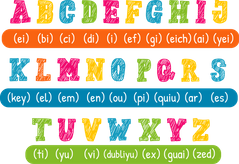- Barajar
ActivarDesactivar
- Alphabetizar
ActivarDesactivar
- Frente Primero
ActivarDesactivar
- Ambos lados
ActivarDesactivar
- Leer
ActivarDesactivar
Leyendo...
Cómo estudiar sus tarjetas
Teclas de Derecha/Izquierda: Navegar entre tarjetas.tecla derechatecla izquierda
Teclas Arriba/Abajo: Colvea la carta entre frente y dorso.tecla abajotecla arriba
Tecla H: Muestra pista (3er lado).tecla h
Tecla N: Lea el texto en voz.tecla n
![]()
Boton play
![]()
Boton play
![]()
18 Cartas en este set
- Frente
- Atrás
|
Verb to be.
Verbo ser o estar. |
AM, IS, ARE
|
|
When do we use the verb to be?
¿Cuándo usamos el verbo to be? |
We use the verb to be (am, is are) to talk about names, professions, nationalities, age, feelings, marital status, the weather.
Traducción: Usamos el verbo to be (am, is are) para hablar de nombres, profesiones, nacionalidades, edad, sentimientos, estado civil, el clima. |
|
Examples of the verb to be.
Ejemplos del verbo to be. |
- I am a teacher.
- He is married. - She is happy. - We are Nicaraguan. - It is very cold today. |
|
Structure - The verb to be (am, is, are) (POSITIVE)
Estructura - Verbo to be (ser o estar) (POSITIVO) |
Positive:
I am - Yo soy You are - Tu eres He is - Él es She is - Ella es It is - Eso es We are - Nosotros somos They are - Ellos son |
|
Structure - The verb to be (am, is, are) (NEGATIVE)
Estructura - Verbo to be (ser o estar) (NEGATIVO) |
Negative:
I am not - Yo no soy You are not - Tu no eres He is not - Él no es She is not - Ella no es It is not - Eso no es We are not - Nosotros no somos They are not - Ellos no son |
|
Structure - The verb to be (am, is, are) (QUESTION)
Estructura - Verbo to be (ser o estar) (PREGUNTA) |
Question:
Am I...? - ¿Soy yo? Are you...? - ¿Eres tu? Is he...? - ¿Es él? Is she...? - ¿Es ella? Is it...? - ¿Es eso? Are we...? - ¿Somos nosotros? Are they...? - ¿Son ellos? |
|
Affirmative sentences.
Oraciones afirmativas. |
Subject + verb to be (am, is, are) + complement
Sujeto + verbo to be + complemento. |
|
Examples of Affirmative sentences.
Ejemplos de oraciones afirmativas. |
- He is a doctor - Él es un doctor.
- She is single - Ella está soltera. - We are sad - Estamos tristes. - It is very hot - Está muy caliente. |
|
Negative sentences.
Oraciones negativas. |
Subject + verb to be (am, is, are) + not + complement
Sujeto + verbo to be + no + complemento. |
|
Examples of negative sentences.
Ejemplos de oraciones negativas. |
- We are not friends - No somos amigos
- I am not at work - No estoy en el trabajo. - It is not a big house - No es una casa grande. - You are not funny - No eres gracioso. |
|
Questions
Preguntas |
verb to be (am, is, are) + subject + complement?
verbo to be + sujeto + complemento? |
|
Examples of questions
Ejemplos de preguntas. |
- Are you from Mexico? - ¿Eres de México?
- Is he in the classroom? - ¿Está él en aula de clases? - Is she the best student? - ¿Es ella la mejor estudiante? |
|
When do we use possessive pronouns?
¿Cuándo usamos pronombres posesivos? |
We use possessive pronouns to show ownership, possession of something.
Usamos pronombres posesivos para mostrar propiedad, posesión se algo. |
|
Possessive pronoun: subject pronoun.
|
- I have a shirt - Tengo una camisa.
- You have a book - Tienes un libro. - He has a pillow - Él tiene una almohada. - She has a dog - Ella tiene un perro. - It has a bone - Tiene un hueso. - We have a bird - Tenemos un pájaro. - You have a house - Tienen una casa. - They have a car - Ellos tienen un carro. |
|
Possesive adjective.
|
MY: My shirt is green - Mi camisa es verde.
YOUR: Your book is new - Tu libro es nuevo. HIS: His pillow is soft - Su almohada es suave. HER: Her dog is small - Su perro es pequeño. ITS: Its bone is old - Su hueso es viejo. OUR: Our bird is noisy - Nuestro pájaro es ruidoso. YOUR: Your house is big - Su casa es grande. THEIR: Their car is slow - Su carro es lento. |
|
Wh Questions
|
What? - ¿Qué?
Who? - ¿Quién? Where? - ¿Dónde? How? - ¿Cómo? When? - ¿Cuándo? Wich? - ¿Cuáles? Why? - ¿Por qué? |
|
The Alphabet.
El Abecedario. |

|
|
The numbers 1-10
Los números 1-10 |

|